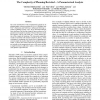Free Online Productivity Tools
i2Speak
i2Symbol
i2OCR
iTex2Img
iWeb2Print
iWeb2Shot
i2Type
iPdf2Split
iPdf2Merge
i2Bopomofo
i2Arabic
i2Style
i2Image
i2PDF
iLatex2Rtf
Sci2ools
116
click to vote
AAAI
2012
2012
The Complexity of Planning Revisited - A Parameterized Analysis
The early classifications of the computational complexity of planning under various restrictions in STRIPS (Bylander) and SAS+ (B¨ackstr¨om and Nebel) have influenced following research in planning in many ways. We go back and reanalyse their subclasses, but this time using the more modern tool of parameterized complexity analysis. This provides new results that together with the old results give a more detailed picture of the complexity landscape. We demonstrate separation results not possible with standard complexity theory, which contributes to explaining why certain cases of planning have seemed simpler in practice than theory has predicted. In particular, we show that certain restrictions of practical interest are tractable in the parameterized sense of the term, and that a simple heuristic is sufficient to make a well-known partialorder planner exploit this fact.
AAAI 2012 | Complexity Analysis | Complexity Theory | Computational Complexity | Intelligent Agents |
| Added | 29 Sep 2012 |
| Updated | 29 Sep 2012 |
| Type | Journal |
| Year | 2012 |
| Where | AAAI |
| Authors | Christer Bäckström, Yue Chen, Peter Jonsson, Sebastian Ordyniak, Stefan Szeider |
Comments (0)

